Chasing Mount Ararat

“My grandfather would always request that my father bring back bags of sugar from his travels, but then proceed to lock them up in a cabinet and never consumed the sugar himself. When I asked why, he would say, ‘the sugar is only for the guests’…this, is Kurdish hospitality.” Bilal recounts.
Moving towards the Iranian border, we hop on a bus from Van to Doğubeyazit, our last stop in Turkey. While the dusty streets of Doğubeyazit may have some of the markings of a typical border town – slightly chaotic, heavily trafficked, just that little bit tougher and far from clean, it is impossible to define it as ordinary or commonplace. The drive into the valley where Doğubeyazit dwells is breathtaking. The hills guarding the entrance are carpeted over with light green moss and charcoal black volcano rock reminding us of Iceland, before opening up to the never-ending rust-coloured plains of the Ağri province. At 1625m, Doğubeyazit is surrounded by miles of flat alpine tundra and watched over by Turkey’s highest peak – Mount Ararat.
In the summer, the town fills up with well-equipped climbers eager to reach Ararat’s snowy summit and while we had no intention of conquering it this time round, from the moment we arrived in town, a game of hide-and-seek began between the elusive peak and us. Many hotels and bars boast about having the best views of Ararat from their terrace, unfortunately most of these architectural constructions from the 70s are having their views dwarfed by new buildings going up all over town. Just when you think you will see the whole mountain, scaffolding greets you instead.
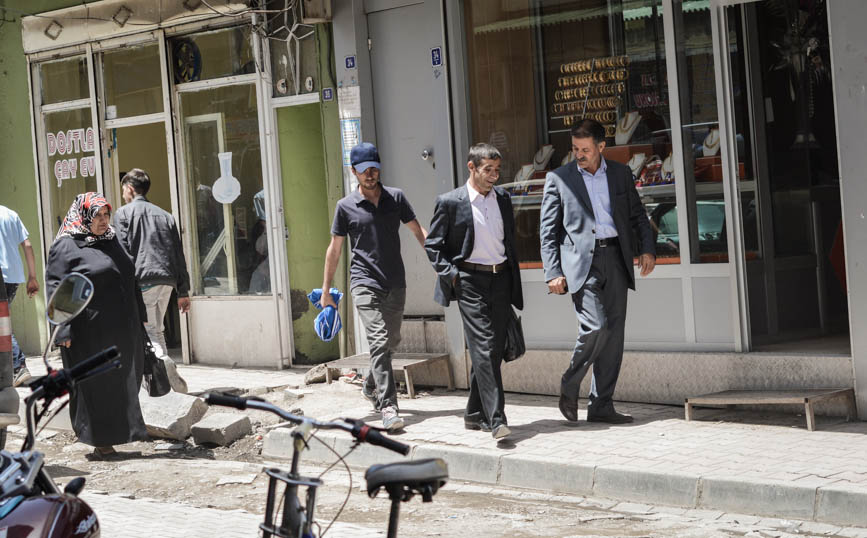
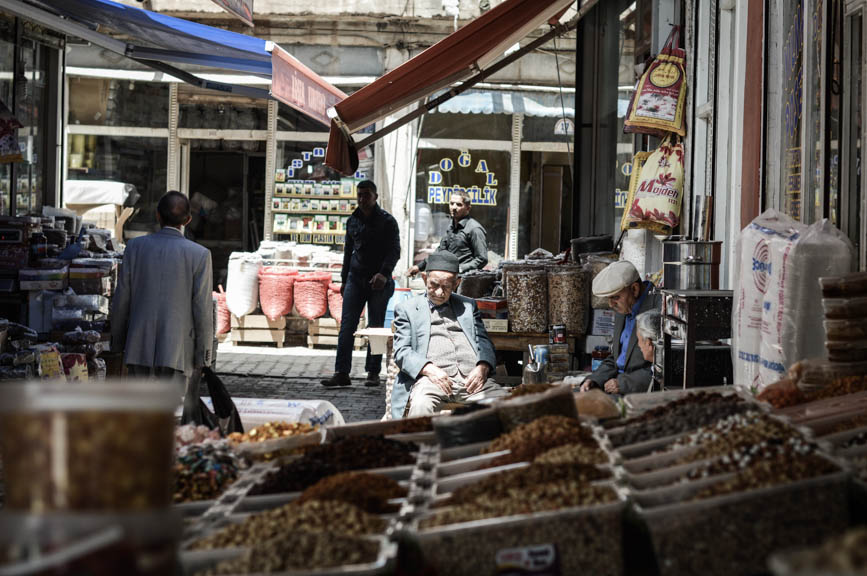
Most afternoons the shilli (kurdish for rain) comes calling, bringing with it heavy carbon skies and clouds that do just as good a job at covering Mount Ararat’s peak as the scaffolding. We wait it out and once it lightens up, we set about exploring our new home. The city’s streets are sticky with mud puddles, the valley air polluted and mostly emitting odours that make you want to hold your breath, though initially rough-around-the-edges, the hospitality of the people shines through once again. A population with a kurdish majority, they take their guests seriously and as we walked through the bazaar, we were treated to a bag of fresh peas, free water and several apricots. Back at the hotel, Bilal explains to us how a foreign guest is seen as a gift from God and that as a child, there was always a guest room in his house. Children were forbidden to enter as the exquisitely kept room had to be ready at any moment to welcome an unexpected guest. We have encountered this throughout our meetings with people in eastern Turkey and learning a few words of Kurdish can bring out the biggest smile in your host.
In Doğubeyazit we sample our first Samar Biyek, a thin tortilla like bread wrapped around succulent minced beef with onions, herbs and baked in the form of a massive sausage roll to be served sliced up and dipped in tomato sauce accompanied by bulgur pilav. A word of “supas” (thank you in kurdish, sounds like spass) sends the waiter running to tell everyone that the tourists spoke kurdish as we get approving grins all round. They teach us a few more kurdish words – “naan” (bread, in turkish ekmek), “sherbash” (goodnight, in turkish ee-gejeleer), “roshbash” (good morning, in turkish gunaydin) and we soon realise we are learning kurdish through turkish!
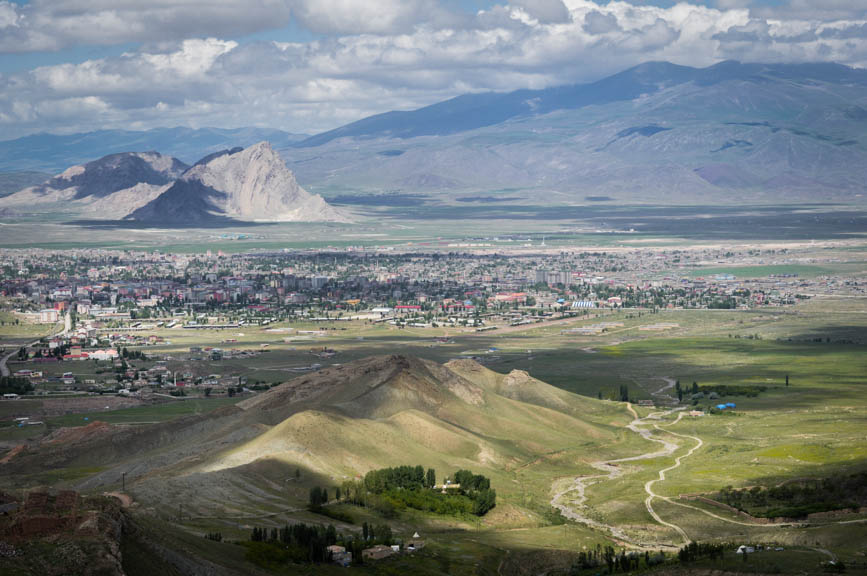
The next morning fuelled by our samar biyek we decide to take advantage of the sun and set off to explore the landmark Ishak Pasha Palace. This magnificent piece of architecture sits on its throne surveying the valley plains of Doğubeyazit below. The Palace, named after the General İshakpaşa marks a strategic point along the Silk Road and is a symbol of the region’s tumultuous past. The flat plains were a perfect resting ground for the combatants arriving through the treacherous mountain ranges and changed hands numerous times throughout history, having been conquered by Persians, Romans, Arabs, Byzantines and Mongols, before the Turks arrived. The town of Beyazit succumbed to continuous invasions, including during the Russo-Turkish War of 1877 when the Palace provided an important defence point. After that the town’s originally Armenian settlement left to build New Beyazit (now Gavar in Armenia) and was replaced by a Kurdish population by 1930. The city was destroyed once again during the Turkish War of Independence and rebuilt as Doğubeyazit, literally meaning “East Beyazit”.

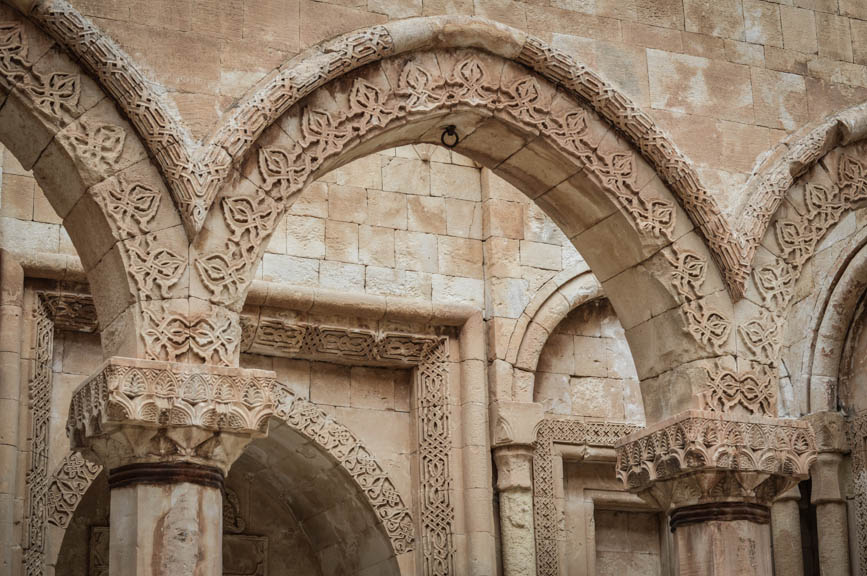

The Palace was built by several generations of Pasha men, supposedly completed by Mehmet Pasha around 1784. The stunning structure combines Anatolian, Iranian and North Mesopotamian influences to produce an impressive sight. Upon entering the courtyard, there is a large reception hall on the right, now covered by PVC roofing to protect it from weather elements. I could not help but wonder what throwing a big party here would be like, lit up with live music and dancing dresses. In a shocking contrast, underground are the brooding dungeons, rows of stone chambers, cold and hidden from light where one of Napoleon’s spies said that they would lower prisoners in through a hole in the ceiling. Good luck escaping from that special hell. The servants’ quarters are also subterranean, making you wonder how dark or smokey it would have been with candles and cooking over open fires taking place. The kitchen is a massive dome-shaped room, the roof and edges licked black with oil from when soldiers used the palace as a barricade during the war. Perhaps the most well-known section of the Palace is the extensive harem, corridors of countless rooms looking out over the valley, dwellings for the Pasha’s concubines and wives. The large visible exterior dome of the Palace is the old mosque, miraculously still intact, the striking fresco still vibrant towards the heavens.

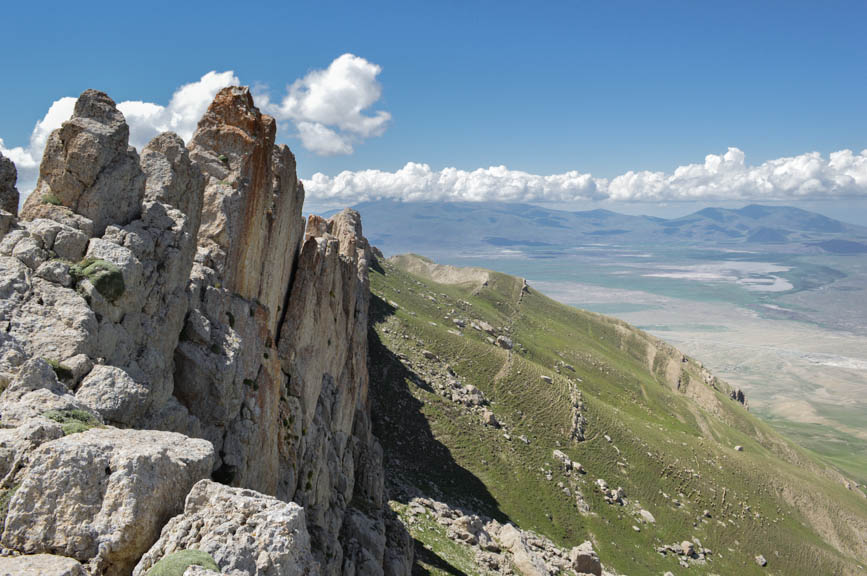
After the historical visit, we decide to continue our original mission of catching a glimpse of Ararat’s peak. Bilal had told us that just behind the Palace, about a two hour walk up Mount Birek there is the best view. We beginning climbing up one big chunk of caramel rock only to realise that behind it stood another toffee block. We spot a path going up the mountain and decide to chance that instead. In the rather deep valley of Mount Birek, only a chain of spiky rock is visible, but we want to believe that Ararat is just behind. We continue the steep ascent and suddenly we are three hours in with still no view of Ararat. Approaching the top of a large green plain, I am certain that we have reached the peak, excitement mounts as I pick up the pace, gasping to see what lies behind…another uphill field. We are tired and hungry, debating whether it is better to stop and take a rest, but deep inside I know that it is now or never. Just a few hundred metres more of steep climbing and we will be there. We head to the edge of the jagged boulder chain and I now understand why women and men have risked their lives to reach the top of the world. When the end is so close in sight, it is impossible to stop. A few more grips and several more shallow breaths and there it is, the peak of Ararat pushing its way through a layer of dense clouds. I feel like crying. At 2600m, we have finally found what we were looking for, Ararat can hide no longer. It is a strange victory to see it from up here, alone and all to ourselves, the challenge making the view that much sweeter. The view over the never-ending plains is breathtaking, a large river lazing through it as we try to make out where the border with Iran lies. We have our best picnic spot yet, us , some cucumbers and Ararat. The clouds gang up against us and cover up the peak once again, it is time to go back down.
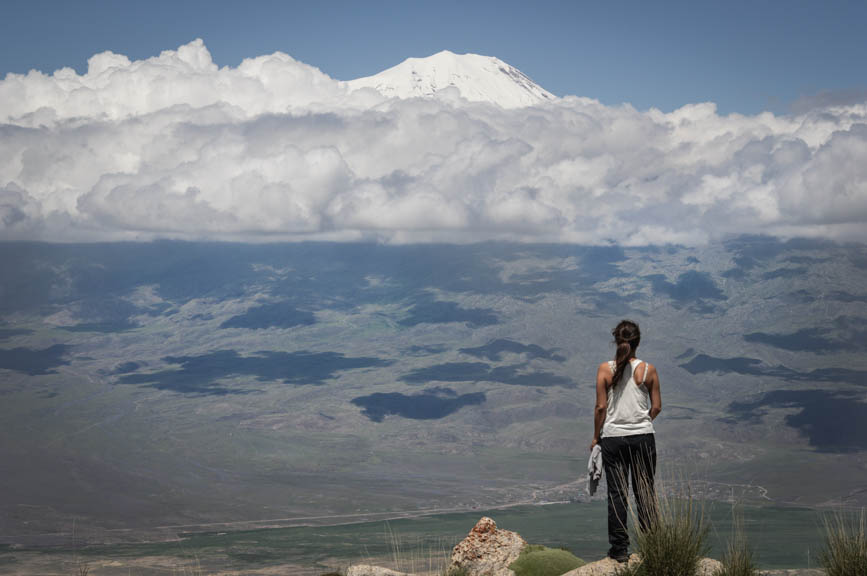
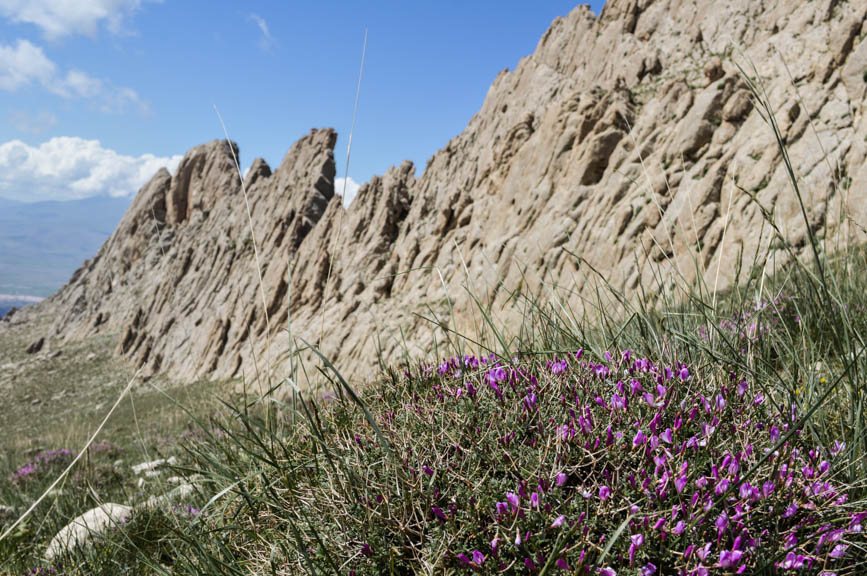
The descent is far easier, gifting us with a well-deserved view of what I have nicknamed the three gems – Ishak Pasha Palace to the left, the old Armenian church to the right and an old mosque bolted into the mountains edge. We will have to earn our way to the bottom, as in our euphoria we take a wrong turn and end up in the corner of the valley, trapped by barbed wire in long-grassed snake territory. A few slivery snakes and big leaps later, a boy herding cows helps us escape the barbed wire and we settle down to a çay at a little kioski, perhaps the best tasting çay so far.
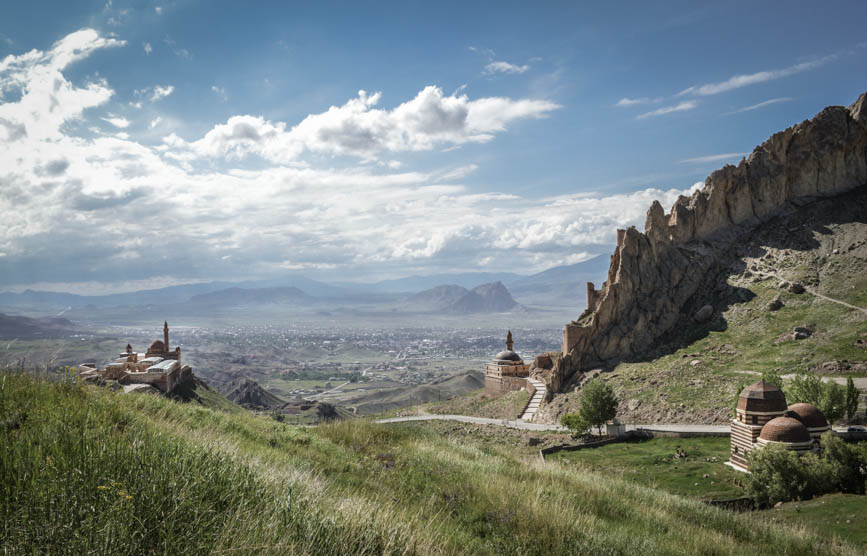
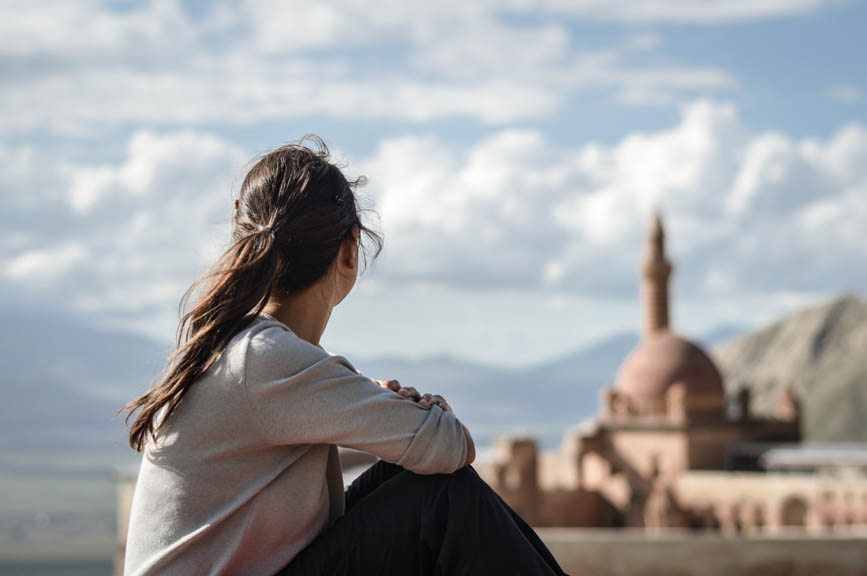
One last look at Ishak Pasha before we are picked up by two heavy smoking samaritans who drive us back into town, once again Eastern Turkey proves to be the easiest place we have hitchhiked in so far. Once in town, we spot Ararat again. Turns out with the right conditions, it is actually quite easy to see the elusive peak from below, almost as a joking tease, it stares down at us, laughing at our efforts. But like most things, having worked for it made it that much more special and I would not have traded it in for anything.
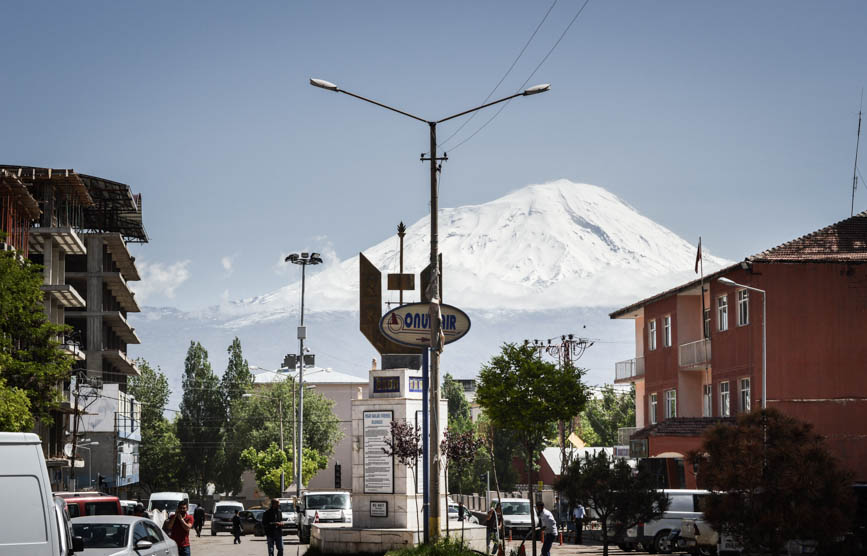
Suddenly the wind kicks up a storm, the loosely nailed metal roofs crackle and clang as the sky flips over buckets of murky raindrops and Ararat is hidden once again. Not one for mundane farewells, Turkey gives us one final splendid present on our last day in the country – an 180 degree rainbow rooted between the constructions old and new, emerges clear and intact. The beautiful colours of Turkey, the warm hearts of its people, will stay with us for a long time.
Teşekkürler & Supas Turkiye.
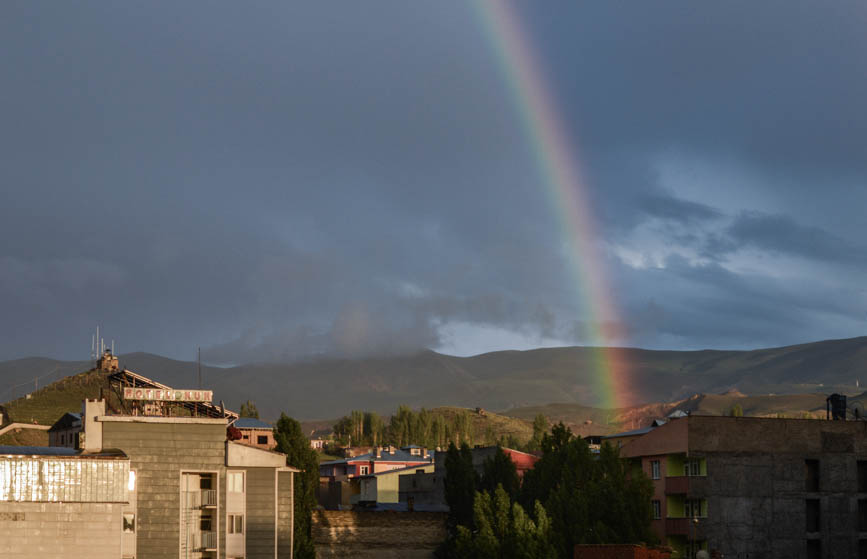
Tomorrow we will cross the border into Iran.







1 Comment
Camilla
July 3, 2014What a beautiful mountain and view! I definitely want to see more of Turkey 🙂